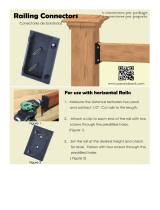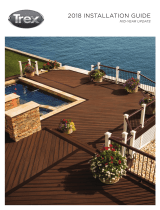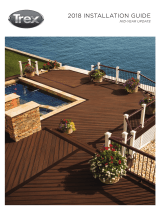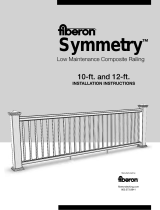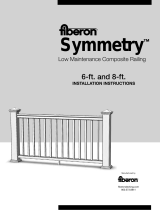Page is loading ...

Prior to construction, check with your local regulatory agency for special
code requirements in your area. Common railing height is 36" or 42". Read
In-Line Railing Installation Instructions
PRE-ASSEMBLED ALUMINUM RAILING
INSTALLATION INSTRUCTIONS
Tools and Items Needed
• Drill/power screwdriver
• Miter or circular saw
with carbide tip blade
• Marked speed square
• Carpenter’s level
• Carpenter’s pencil
• Adjustable wrench
or socket wrench for
bolts, etc.
• Safety glasses/goggles
• Rubber mallet
• Tape measure
• Lag screws
Post
Base Trim
Baluster
Pre-Assembled Aluminum Rail
Post
Cap
Post
Bracket
Support
Block
fig. 1
Pre-drill all screw holes for best results.
instructions completely to get an understanding of how the product goes together and how each piece affects the other.
Step 1 Determine the number of railing posts needed for your deck. Post spacing is 6'
or 8' on-center. Example: A 12' x 16' deck
attached to a building with a 4' access opening on one side will require a total of eight posts.
Step 2 Installing posts: Install posts by attaching the aluminum base to the surface of the deck. Position the post so the fastener will
go into the floor joist, and make sure the decking is firmly attached to the joist at the location of the posts. Proper structural blocking/
framing under the decking material is required when attaching the post to a wood frame deck because decking alone is not approved
as structural framing.
Step 3 Position the post assembly onto the location where it will attach to the deck. Four 3/8" diameter mounting holes are
provided on the base. When the final position is determined, mark the base hole locations. Remove the post assembly and drill
15/64" holes in the marked locations through the decking and into structural blocking.
Step 4 Reposition the post assembly over the predrilled holes and insert the fasteners (not included). Note: Recommend 5/16" x 4"
or longer lag screws. Secure the base to the deck structure. Make certain the posts are plumb. If the post requires adjustment, add
stainless steel washers under the base plate.
Step 5 Finish by sliding a post base trim (optional) over each post for a finished look. Note: Installing the post base trim prior to
installing the bottom rail is recommended. However, the two-piece design does allow the installer to add the post base trim after the rail
has been installed.
Step 6 Measure the distance between installed posts to determine the length of the top and bottom rails (fig.1). Position rail adjacent to
installed posts. The distance between the post and the first baluster should be less than 4" and equal on both ends. Mark the length on
top and bottom rails. Remove an additional 1/2" on both ends (1" overall) for the bracket to fit between the rail and post. Trim the top and
bottom rails to length.
Step 7 Place the brackets on ends of the rails. Attach the brackets to the rails with a screw attached through back of bracket into each
internal screw boss.
Step 8 Check building code requirements for maximum spacing between deck surface and bottom of rail (sweep). Spacing of 3" is
recommended for 36" or 42" finished rail height. Prop rail in place and mark the bracket holes on both posts. Remove rail. Predrill screw
locations through the posts, using a 3/16" drill bit at top bracket locations and 9/64" drill bit at lower bracket locations.
Step 9 A support block is needed every 2 feet (2 are included in the 6ft kit, 3 in the 8ft kit). Attach support block connectors to the
bottom of the lower rail at 2 foot intervals. Predrill using a 1/8" drill bit. Attach the support blocks to the support block connectors. Mark
the location of the support block on the deck surface and attach the other support block connector to the deck using the included
screw.
Step 10 Position the rail between the posts. Check for level end-to-end and vertically. Attach brackets to the post at one end. Repeat
for the other end. Tip: Use a driver extension bit to avoid marring the rail with the drill chuck.
Step 11 Set post caps on each post. Gently tap with rubber mallet to secure.

Step 1 Begin by determining where the top and bottom post will be located.
Mark the desired location of the post. Note: To ensure post location is
compatible with railing, prior to securing to the deck, place both posts in
position, and lay the bottom rail along the stair nosing from top to bottom
adjacent to both posts. On the rail side of the post, measure up from the top
of the rail and ensure there is a minimum of 34" to the top of the post. Post
location may need to be adjusted to ensure minimum is obtained. Repeat this
step for the bottom post. For a wood deck, position the post so the fasteners
will go into the joists, and make sure the decking is firmly attached to the
joists at the location of the posts. Proper structural blocking/framing under the
decking material is required when attaching the post to a wood frame deck
because decking alone is not approved as structural framing.
Step 2 Four 3/8" diameter mounting holes are provided on the base. When
final position is determined, mark hole locations and remove the post assembly.
Drill the marked locations through decking and into structural blocking.
Step 3 Reposition the post assembly over predrilled holes. Insert fasteners (not
provided), then secure the base to the deck structure. Make certain the posts
are plumb. If the post requires adjustment, add stainless steel washers under the
base plate.
Step 4 Finish by sliding a post base trim (optional) over each post sleeve for a
finished look. Note: Installing the post base trim prior to installing the railing is
recommended. However, the two-piece design does allow the installer to add the
post base trim after the rail has been installed.
Step 5 Measure the distance between installed posts to determine the
length of the top and bottom rails. Position the railing on the stairs on top of
a spacer block along the stair nosings. Ensure the balusters are plumb. The
distance between the post and the first baluster should be less than 4" and
equal on both ends. Once the railing is in position, clamp the railing to the
posts. Temporarily assemble the swivel brackets. Position the swivel bracket
in location and mark the rail and post. Repeat for other end of railing. Note:
The distance from the end of the top rail to the first stair baluster will be 1-1/16”
longer than the bottom rail to ensure the balusters are plumb. Add 3/4” to the
marked location on the railing and cut to length.
Step 6 Mark locations of the bracket screw holes on the rails. Remove
brackets. Predrill through the rail only, using a 9/64" drill bit. Attach the front end
of bracket to rails.
Step 7 Mark location of the bracket base screw holes on the post. Include the bracket side cover when determining the center location.
Predrill through the post, using a 9/64" drill bit. Position the base of each bracket with the bracket cover side facing the stairs, and attach to
the post with two screws.
Step 8 A support block is needed every 2 feet (2 are included in the 6ft rail kit, 3 in the 8ft kit). Attach support block connectors to the
bottom of the lower rail at 2 foot intervals using included screws. Predrill using a 1/8" drill bit. Mark the location of the support block on
the step tread and attach the other support block connectors to the step tread.
Step 9 Install the bottom railing between the posts by sliding the brackets together. Attach the side of the bracket with the barrel bolt
to secure in place.
Step 10 Set post caps on each post. Gently tap with rubber mallet to secure.
Stair Railing Installation Instructions
Post
Cap
Post
Sleeve
Post
Sleeve
Mark Rail
for Length
Top and
Bottom Rail
Mark Rail
for Length
Distance Between Posts
fig. 2
Top Rail Bracket
Post Sleeve
Baluster
Bottom Rail Bracket
Bottom Rail
Support Block
Post
Base
Trim
Post
Cap
Top Rail
Equal spacing
on both ends
6'' Max.
fig. 3
THE DIAGRAMS AND INSTRUCTIONS IN THIS BROCHURE ARE FOR ILLUSTRATION PURPOSES ONLY AND ARE NOT MEANT TO REPLACE A LICENSED PROFESSIONAL. ANY CONSTRUCTION OR USE
OF THE PRODUCT MUST BE IN ACCORDANCE WITH ALL LOCAL ZONING AND/OR BUILDING CODES. THE CONSUMER ASSUMES ALL RISKS AND LIABILITY ASSOCIATED WITH THE CONSTRUCTION
OR USE OF THIS PRODUCT. THE CONSUMER OR CONTRACTOR SHOULD TAKE ALL NECESSARY STEPS TO ENSURE THE SAFETY OF EVERYONE INVOLVED IN THE PROJECT, INCLUDING, BUT NOT
LIMITED TO, WEARING THE APPROPRIATE SAFETY EQUIPMENT. EXCEPT AS CONTAINED IN THE WRITTEN LIMITED WARRANTY, THE WARRANTOR DOES NOT PROVIDE ANY OTHER WARRANTY,
EITHER EXPRESS OR IMPLIED, AND SHALL NOT BE LIABLE FOR ANY DAMAGES, INCLUDING CONSEQUENTIAL DAMAGES.
©2018 Universal Forest Products. Deckorators is a registered trademark of Universal Consumer Products, Inc. in the U.S. All rights reserved.
68956 U.S. Highway 131, White Pigeon, MI 49099
10374 11/18
www.lowes.com
/
